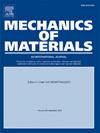On deformation and structural twins in the shape memory alloys
IF 3.4
3区 材料科学
Q2 MATERIALS SCIENCE, MULTIDISCIPLINARY
引用次数: 0
Abstract
Using the NiMnGa shape memory alloy as an example, the article substantiates an approach to describing at the microstructural level the processes of twinning and detwinning of the martensitic phase. The coordinated twinned martensitic structure is described by the Hadamard compatibility equation for deformations, the solution of which made it possible to determine the surfaces along which the shift occurs, the directions and the magnitude of sliding in a tetragonal crystal cell corresponding to the material under consideration in the martensitic state, leading to the appearance and disappearance of the twinned structure. It is shown that two types of twins simultaneously and inseparably exist in an alloy with shape memory: deformation and structural. The first is related to the deformation of a simple shear, that occurs in accordance with the Hadamard compatibility condition in a martensitic plate, which leads to the kink of this straight plate and the appearance of two elements rotated at a certain angle relative to each other, which form this twin. The structural twin is formed from two parts, in each of which the tetragonal crystal cells of martensite are identically oriented, but the short axes of all these tetragonal cells make up an angle of when these cells are located in different parts of the twin. The positions of the structural twin elements relative to the shear plane, determined as a result of solving the twinning equation, are in good agreement with the experimental data. The formation of a deformation twin as a result of a shift in the material leads to the occurrence of a corresponding strain. The formation of a structural twin initiates a structural strain. It is shown that a certain position of the structural twin in the deformation one leads to the equality of these strains.

形状记忆合金的变形与组织孪晶
本文以Ni2MnGa形状记忆合金为例,提出了一种从微观结构层面描述马氏体相孪晶和去孪晶过程的方法。用变形的Hadamard相容方程描述了配位孪晶马氏体结构,该方程的解可以确定在马氏体状态下材料所对应的四方晶胞中发生位移的表面、方向和滑动幅度,从而导致孪晶结构的出现和消失。结果表明,在具有形状记忆的合金中,变形孪晶和组织孪晶是同时存在且不可分割的两种孪晶。第一个与简单剪切变形有关,这种变形发生在马氏体板的Hadamard相容条件下,它导致这个直板的扭结和两个元素以一定的角度相互旋转,形成了这个孪生体。结构孪晶由两部分组成,每一部分的马氏体四方晶胞取向相同,但当这些晶胞位于孪晶的不同部位时,所有这些四方晶胞的短轴形成900角。通过求解孪晶方程,得到了结构孪晶单元相对于剪切平面的位置,与实验数据吻合较好。变形孪晶的形成是由于材料的位移导致相应应变的发生。结构孪晶的形成引起结构应变。结果表明,变形区中结构孪晶的一定位置会导致这些应变相等。
本文章由计算机程序翻译,如有差异,请以英文原文为准。
求助全文
约1分钟内获得全文
求助全文
来源期刊

Mechanics of Materials
工程技术-材料科学:综合
CiteScore
7.60
自引率
5.10%
发文量
243
审稿时长
46 days
期刊介绍:
Mechanics of Materials is a forum for original scientific research on the flow, fracture, and general constitutive behavior of geophysical, geotechnical and technological materials, with balanced coverage of advanced technological and natural materials, with balanced coverage of theoretical, experimental, and field investigations. Of special concern are macroscopic predictions based on microscopic models, identification of microscopic structures from limited overall macroscopic data, experimental and field results that lead to fundamental understanding of the behavior of materials, and coordinated experimental and analytical investigations that culminate in theories with predictive quality.
 求助内容:
求助内容: 应助结果提醒方式:
应助结果提醒方式:


